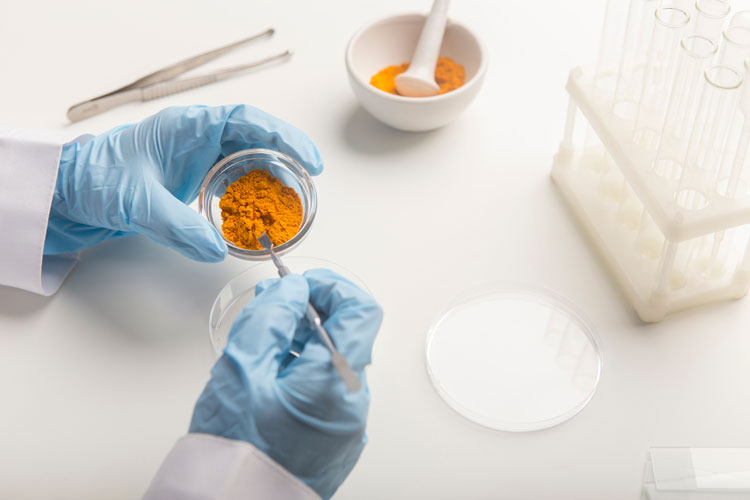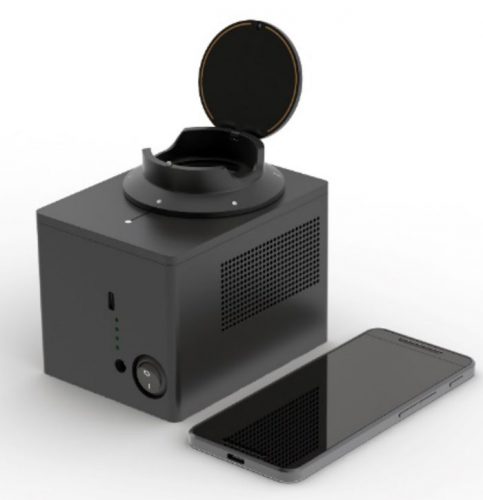Out of the (black) box thinking
- Like
- Digg
- Del
- Tumblr
- VKontakte
- Buffer
- Love This
- Odnoklassniki
- Meneame
- Blogger
- Amazon
- Yahoo Mail
- Gmail
- AOL
- Newsvine
- HackerNews
- Evernote
- MySpace
- Mail.ru
- Viadeo
- Line
- Comments
- Yummly
- SMS
- Viber
- Telegram
- Subscribe
- Skype
- Facebook Messenger
- Kakao
- LiveJournal
- Yammer
- Edgar
- Fintel
- Mix
- Instapaper
- Copy Link
Posted: 11 November 2020 | Professor Chris Elliott | No comments yet
Professor Chris Elliott explains why current methods for detecting food fraud along supply chains are in need of a refresh and outlines the work he and his team are conducting in order to help.


The majority of scientific testing for food safety and food authenticity purposes in feeds and foods requires samples to be collected from various points in the supply chain and dispatched to laboratories. This is how it has been done for a long time, but there is a growing need and demand from industry to move to more on-site testing.
Several factors are driving this. The time it takes to carry out laboratory-based analysis is generally in the range of several weeks to one month. Furthermore, transportation of the samples takes time and expense. The samples have to be logged and entered into workflows, which usually means batch-based testing on a weekly or biweekly basis. The results from the testing must then be calculated, checked and finally reported.
A week, let alone a fortnight, is a very long time in the food chain. Businesses have to decide whether to hold the food commodities and ingredients in storage until the results are known, which is a costly undertaking, or risk allowing the food to pass onto the next stages of the supply chain prior to receiving results. The major risk is that a serious food safety or adulteration may be detected, meaning the materials must be prevented from reaching the consumer. In the complex world of supply chains, this presents enormous challenges and potentially massive costs to the industry.
There is also the added risk that a food recall must be conducted, which can severely damage the reputation of the businesses involved.
The status quo of laboratory-based testing has been in need of disruption for some time; however, the best way to achieve this has posed substantial challenges to the analytical community.
The majority of scientific testing for food safety and food authenticity purposes in feeds and foods requires samples to be collected from various points in the supply chain and dispatched to laboratories. This is how it has been done for a long time, but there is a growing need and demand from industry to move to more on-site testing.
Several factors are driving this. The time it takes to carry out laboratory-based analysis is generally in the range of several weeks to one month. Furthermore, transportation of the samples takes time and expense. The samples have to be logged and entered into workflows, which usually means batch-based testing on a weekly or biweekly basis. The results from the testing must then be calculated, checked and finally reported.
A week, let alone a fortnight, is a very long time in the food chain. Businesses have to decide whether to hold the food commodities and ingredients in storage until the results are known, which is a costly undertaking, or risk allowing the food to pass onto the next stages of the supply chain prior to receiving results. The major risk is that a serious food safety or adulteration may be detected, meaning the materials must be prevented from reaching the consumer. In the complex world of supply chains, this presents enormous challenges and potentially massive costs to the industry.
There is also the added risk that a food recall must be conducted, which can severely damage the reputation of the businesses involved.
The status quo of laboratory-based testing has been in need of disruption for some time; however, the best way to achieve this has posed substantial challenges to the analytical community.
Research at Queen’s University Belfast IGFS
Over the last decade, myself and my research group – based within the Institute for Global Food Security (IGFS) – has developed a rather unique technology centre. Working with a range of technology providers, we have investigated dozens of devices designed for field-based safety and authenticity testing – many of which came from the pharmaceutical and life science sectors.


The Bia Analytical ‘black box’ upon which samples can be placed and tested
While numerous devices showed promise, they often fell short of the demands placed upon them. Challenges with the hardware, software and measurement capabilities were frequent issues. Our ultimate conclusion was that spectroscopic-based approaches that employ the ‘food fingerprinting’ principle were the most likely to deliver what is needed.
In essence, the concept is based on taking multiple scans of hundreds of individual samples of food commodities and ingredients of known provenance at different wavelengths. These scans are then collected and subjected to statistical analysis (chemometrics) to provide the ‘physiochemical fingerprint’. Samples of unknown provenance can then be scanned and compared to these fingerprints. Those showing good agreement are deemed to be ‘authentic’ and those that do not are deemed to be highly suspicious. These chemometric models have been shown in our hands to be correct between 85 and 95 percent of the time; thus, they provide very useful information but are not fool proof.
We then decided that this testing would be referred to as ‘Tier 1 screening’ and any highly suspicious samples would be subjected to a more sophisticated ‘Tier 2 confirmatory’ analysis based on mass spectrometry. This two-tier approach can provide a substantially increased level of testing through rapid screening, inside or outside of the laboratory, with laboratory-based mass spectrometry-based analysis, to verify the result obtained.
Our first major implementation of this two-tier strategy occurred several years ago when we investigated fraud in the world of herbs and spices. We targeted oregano (based on an industry tip off) and found that over 25 percent of all samples we tested from around the world were adulterated.1 This prompted a massive clamp down on fraud in oregano in many parts of the world. Yet the Tier 1 testing was still on a laboratory-based instrument. Very recently we have achieved the same testing approach, but this time for rice and – even more importantly – Tier 1 utilised a low-cost handheld device.2 Using this approach, we are now testing rice samples collected from across Europe in a Citizen Science Project. We hope to report the results of our survey in New Food before the end of this year.
We achieved substantial professional satisfaction in developing a pioneering two-tier approach for the detection of fraud and from conducting the survey work. However, I realised that universities are not the appropriate place to conduct large-scale testing for food businesses across the world. Thus, I embarked on establishing a company that would do precisely that.
Partnership with Bia Analytical
Bia Analytical was established in 2020 and raised more than £500,000 investment to build upon the authenticity testing and research activities undertaken within the IGFS. The company’s initial product offering focuses on testing authenticity in the herbs and spices supply chain. Exciting plans are now also afoot to expand its product offerings to additional ingredients that are sourced from regions where there is a higher risk of adulteration.
The company aims to provide industry with a rapid laboratory-based authenticity testing service, using spectrometry in conjunction with chemometric modelling, which is recognised as better suited for the determination of Economically Motivated Adulteration (EMA). Samples are analysed and reported within three days of receipt. The company also offers bespoke method development where it develops chemometric models to meet individual business needs.
Bia’s vision is to support the food industry by helping to speed up decision-making on key ingredients as they are received at manufacturing plants. By doing so, companies will be able to ensure ingredients can be safely used in production.
This will be achieved by providing a portable testing solution that allows authenticity screening to be performed, directly by businesses or their agents, at the point of sampling. Users of the platform can rapidly test samples by placing them onto the bespoke portable device and, by means of a dedicated app, receive the screening result within seconds, directly on their mobile phone. The ‘black box’ we are developing is based on cutting-edge science and technology; but like all good black boxes, the end users do not need to know the details – the customer can simply scan and wait for a few seconds for the results to appear on their phone.
Meanwhile, all sample results from businesses are stored in the Cloud to allow further processing, such as trend analysis, to be performed through a browser-based dashboard. Bia is putting the finishing touches to its demonstration instrumentation and building the first portable authenticity models for the herbs and spices sector. An additional 24 commodity authenticity models will be available for both the lab-based and portable devices by April 2021.
And this is only the start; Bia is working closely with my research group to determine what the next targets should be in terms of food commodities and ingredients. The company is now actively seeking partners to run trial tests with, to ensure that this portable solution meets the needs of the food industry. Trials were anticipated to begin September 2020. If you are interested in getting involved in testing the portable solution, visit: www.bia-analytical.com.
Conclusion
This is a story of having a research idea based on the knowledge that food safety and food fraud are hugely important topics. Also, acknowledging that, to improve the detection of accidental and deliberate contamination where food is being produced and distributed, some form of disruption is needed. The selected technology platform and how it operates is ground breaking and will become an indispensable tool for many businesses to protect their supply chains – and ultimately the consumer.
And for those who were wondering where the Bia name came from; it’s quite simple: Bia is the Irish name for food!
References
- https://www.sciencedirect.com/science/article/pii/ S030881461630680X
- https://academic.oup.com/jaoac/advance-article- abstract/doi/10.1093/jaoacint/qsaa109/5894477?redirected From=fulltext
About the author
Chris Elliott
Chris is the Professor of Food Safety and Director of the Institute for Global Food Security at Queen’s University Belfast. He has published around 300 peer‐reviewed articles, many of them relating to the detection and control of agriculture, food and environmental related contaminants. His main research interests are in the development of innovative techniques to provide early warning of toxin threats across the agri‐food chains. Chris led the independent review of Britain’s food system following the 2013 horsemeat scandal and he is a member of the New Food Advisory Board.
Issue
Related topics
Equipment, Food Fraud, Ingredients, New product development (NPD), Product Development, Research & development, Spectroscopy, Supply chain, Technology & Innovation









